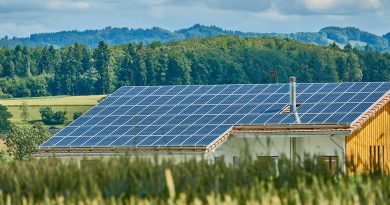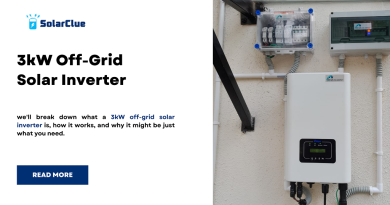What Is A Grid Connected Solar Rooftop System?
A grid-connected solar rooftop system involves installing a solar power system on the rooftops of buildings and linking it to the electrical grid. It empowers individuals and businesses to harness solar energy and generate their own electricity. As solar energy gains popularity, acquiring knowledge about how a grid-connected solar rooftop system operates, its benefits, and the setup process becomes crucial for those interested in sustainable energy solutions. In this blog, we will comprehensively overview grid-connected solar rooftop systems, delving into their components, functioning, advantages, and more.
Table of Contents
The Components of a Grid Connected Solar Rooftop System
A grid connected solar rooftop system consists of several key components working together to generate electricity. These components include:
1. Solar Panels: Solar panels are the most visible part of the system, typically installed on the rooftop or any suitable surface to capture sunlight. These panels contain photovoltaic (PV) cells that convert sunlight into electricity.
2. Inverter: The inverter is a crucial component of the system that converts the Direct Current (DC) electricity generated by the solar panels into Alternating Current (AC) electricity, which can be used to power electrical devices or fed into the electrical grid.
3. Mounting Structure: The mounting structure supports the solar panels and ensures they are securely fixed on the rooftop. It should be sturdy enough to withstand different weather conditions and properly positioned to maximize sunlight capture.
4. Electrical Meter: An electrical meter, often called a net meter or bidirectional meter, measures the amount of electricity produced by the solar rooftop system and provides real-time data on energy consumption and generation.
5. Electrical Switchgear: The switchgear includes circuit breakers, fuses, and other protective devices that help control and protect the system from electrical faults or overloads.
How Does a Grid Connected Solar Rooftop System Work?
The functioning of a grid connected solar rooftop system is relatively simple yet efficient. Let’s dive into the step-by-step process:
1. Solar Panels Capture Sunlight: When sunlight falls onto the solar panels, the PV cells within the panels absorb the photons, which then generate an electrical current, known as Direct Current (DC).
2. Inverter Converts DC to AC: The DC electricity generated by the solar panels is sent to the inverter. The inverter converts this DC electricity into AC electricity, which aligns with the electrical standards used in homes and businesses.
3. Power Consumption and Export: Once the system converts electricity to AC, it powers electrical appliances within the building. The system automatically exports any excess electricity, not consumed by the building, to the electrical grid.
4. Grid Interaction: When the solar rooftop system produces surplus electricity beyond the building’s needs, it transmits the excess to the grid. Conversely, if the building’s electricity demand surpasses the solar system’s generation capacity, it draws electricity from the grid.
5. Net Metering: The utility company, which manages the electrical grid, uses a net meter or bidirectional meter to measure the electricity imported from or exported to the grid. When the grid receives excess electricity, the meter records it as an export. Conversely, when the grid supplies electricity that is consumed, it is recorded as an import.
The Advantages of a Grid Connected Solar Rooftop System
Grid connected solar rooftop systems offer numerous advantages for both individuals and the environment. Some of the most notable benefits include:
1. Cost Savings: By generating electricity from a renewable source, households and businesses can significantly reduce their electricity bills. The excess electricity exported to the grid may even result in a credit or compensation from the utility company.
2. Environmental Friendliness: Solar energy is a clean and renewable energy source that produces no greenhouse gas emissions during operation. By installing a grid connected solar rooftop system, individuals contribute to reducing their carbon footprint and combatting climate change.
3. Energy Independence: With a grid connected solar rooftop system, individuals become less dependent on traditional energy sources such as coal or natural gas. By generating their own electricity, they have greater control over their energy consumption and are less susceptible to fluctuating energy prices.
4. Long-Term Return on Investment: Although the upfront costs of installing a solar rooftop system can be substantial, it offers a long-term return on investment. Over time, the electricity savings accumulated and potential incentives or tax benefits can outweigh the initial installation expenses.
5. Grid Stability: Grid connected solar rooftop systems contribute to enhancing the stability and reliability of the electrical grid. Distributed solar energy generation reduces the strain on centralized power generation facilities, making the grid more resilient to outages or emergencies.
The Set-Up Process of a Grid Connected Solar Rooftop System
Setting up a grid connected solar rooftop system involves several steps to ensure its proper functioning and compliance with local regulations. Here is a general overview of the set-up process:
1. Site Assessment: A professional solar installer assesses the rooftop’s suitability for solar panel installation. Factors like orientation, shading, and structural integrity are evaluated to determine the optimal placement and capacity of the system.
2. System Design: Based on the site assessment, the installer designs the solar rooftop system, considering the required number and arrangement of solar panels, appropriate inverter capacity, mounting structure, and integration with local regulations and electrical codes.
3. Permitting and Approvals: Before installation, the installer handles the necessary permits and approvals from local authorities, ensuring compliance with building regulations and electrical safety standards.
4. Installation: Install the solar panels, inverters, and mounting structures on the rooftop according to the design plan. Make the electrical connections and implement safety measures to guard against electrical faults and fire hazards.
5. Grid Connection: After the installation is complete, the system is inspected by the utility company or relevant authorities to ensure its adherence to safety standards. Once approved, the connection to the electrical grid is established, allowing the system to start generating electricity and interacting with the grid.
Conclusion
In conclusion, the grid-connected solar rooftop system stands as an innovative solution, enabling individuals and businesses to generate clean electricity from the sun while staying seamlessly connected to the electrical grid. With SolarClue® as your trusted ally, this cutting-edge technology opens doors to significant advantages, including cost savings, reduced carbon footprint, and active contribution to a more sustainable future.
Explore the components, delve into the functioning process, and unlock the myriad benefits offered by a grid-connected solar rooftop system. SolarClue® guides you every step of the way, making this option even more appealing for those eager to embrace renewable energy. Understanding the setup process and seeking professional advice from SolarClue® allows anyone to embark on the journey towards a grid-connected solar rooftop system, taking a substantial stride towards energy independence. Don’t just adapt to the future—shape it with SolarClue® and experience the power of clean, sustainable energy.
Frequently Asked Questions
A grid-connected solar rooftop system is a solar power setup on a roof directly linked to the electrical grid, allowing bidirectional energy flow.
It harnesses sunlight through rooftop solar panels, converts it to electricity, and allows for the utilization of grid power when needed.
Benefits include reduced electricity bills, potential income from excess energy, and a continuous power supply through grid integration.
Yes, a grid-connected system enables you to draw power from the grid when solar production is insufficient, ensuring a constant energy supply.
Excess energy can be fed back into the grid, often leading to credits or financial compensation through mechanisms like net metering.
It is most effective in areas with reliable grid connectivity, making it suitable for urban and suburban environments.
Installation involves mounting solar panels on the rooftop, connecting them to an inverter, and integrating the system with the electrical grid.
Regular cleaning of solar panels and monitoring system performance are typical maintenance tasks.
No, for safety reasons, grid-connected systems automatically shut down during power outages to prevent backfeeding electricity into the grid.
Many regions offer incentives, tax credits, or rebates to encourage the adoption of grid-connected solar rooftop systems.



